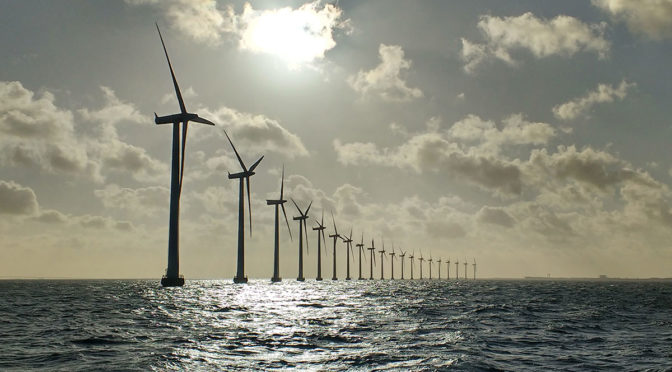Equinor, Mayflower Wind Energy, and Vineyard Wind placed winning bids totaling $405 million to begin planning wind farms.
A highly-competitive auction for three offshore wind lease areas off the coast of Massachusetts concluded today with winning bids totaling a record-breaking $405 million dollars from Equinor; Mayflower Wind Energy, a Royal Dutch Shell and EDP Renewables joint venture; and Vineyard Wind. The completion of this auction kicks off a period of planning for each of these winning companies, including multiple opportunities for feedback from the public and interested parties, before the construction of wind farms can begin.
A total of 11 companies participated in the auction, including global leaders in offshore energy development and land-based wind developers, reflecting surging interest in America’s emerging offshore wind market. Winning bids for all three of the Massachusetts lease areas far exceed the previous record bid for a single lease area, set by a $42.5 million bid from Equinor (then Statoil) in a 2016 New York lease auction. Because these leases are in federal waters, winning bids and subsequent lease payments will provide a significant boost to federal revenue.
“The intense competition we’ve seen in this offshore wind lease auction is completely unprecedented. With strong support from Secretary Zinke, Massachusetts and other states, global businesses now recognize the potential of America’s world-class offshore wind resources,” said Nancy Sopko, Director, Offshore Wind, for the American Wind Energy Association. “Today’s biggest winners are the American workers who will help build and operate these wind farms and the consumers who will soon have access to a new large-scale source of clean, reliable electricity.”
Earlier this year, Massachusetts doubled its offshore wind goal to 3.2 gigawatts (GW) by 2035 – one of the most ambitious offshore wind policies in the nation. If fully developed, the auctioned Massachusetts lease areas could support approximately 4.1 GW of commercial wind generation, enough electricity to power nearly 1.5 million homes, according to the Bureau of Ocean Energy Management (BOEM).
BOEM, a part of the U.S. Department of the Interior, is responsible for offshore wind energy area identification and leasing on the Outer Continental Shelf. Interior Secretary Ryan Zinke has emphasized that the expansion of offshore wind is a key element in the Trump Administration’s made-in-America energy strategy. To date, including today’s auction results, BOEM has awarded 16 commercial offshore wind leases off the coast of every state from Massachusetts to North Carolina.
The Block Island Wind Farm, America’s first offshore wind project, helped transform U.S. offshore wind from a promising idea into a viable industry when the project came online in 2016. The Interior Department’s strong support, coupled with ambitious state policies like those in Massachusetts, sends a clear signal to investors and offshore energy developers that the U.S. offshore wind sector is open for business.
Harnessing offshore wind will result in major new investments in U.S. infrastructure, including port facilities and supply chain factories. Already, Massachusetts is making improvements to the New Bedford Marine Commerce Terminal and MHI Vestas is investing $35 million in an offshore wind turbine gearbox testing facility at Clemson University in South Carolina.
Land-based wind already supports over 105,000 U.S. jobs and scaling up the offshore wind sector holds similar promise. One study indicates coastal communities could see over 36,000 new jobs in the next 10 years alone. Offshore wind development will create good jobs in construction, maintenance and manufacturing that add to the strength of America’s maritime economy.


